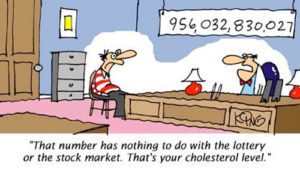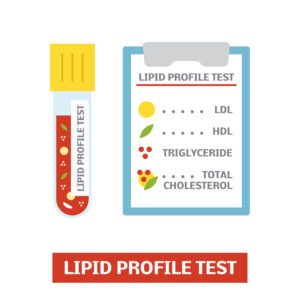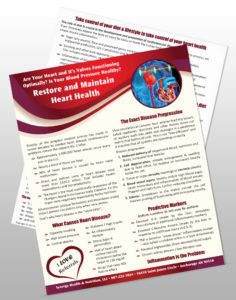Why not everyone thinks “high Cholesterol” is high…
Cholesterol is essential to your health. Every cell in your body needs it to make vitamin D, to make cell membranes, for making hormones including estrogen, testosterone, progesterone, cortisol, more… Cholesterol-derived hormones maintain calcium levels to build strong bones and muscles, keep our blood sugar levels balanced, and help manage stress.
Cholesterol—a waxy, fatty substance—doesn’t float freely in the blood—which is mostly water—it must be carried by lipoproteins, particles formed in the liver to send many different fatty substances around the body (hormones, fatty vitamins like vitamin A, D, E, etc.). There are several types, including high-density lipoprotein (HDL), which is also an antioxidant and brings fatty waste back to the liver from, well, everywhere…, various non-HDL lipoproteins, including intermediate-density lipoprotein (IDL), LDL and very-low-density lipoprotein (VLDL). These lipoproteins are what we call “cholesterol” on a blood test, but they are much more.
If our body is making something that harms it, there must be a reason. So why the bad rap?
Is cholesterol above 180 mg/dL really a problem? Is 180 mg/dL even the right target?

Why would your body make excessive amounts of some lipoprotein types and not enough of others?
Do total blood cholesterol measures even provide a complete picture. To say a person’s cholesterol is “high” ignores the wide body of science. What, exactly, does “high” mean? Can it go too low? There is tremendous research that suggests higher levels protect us from early aging, from Alzheimers, and can improve cardiac health: heart disease isn’t determined by high total cholesterol.
High total cholesterol should not be used alone to make medical decisions.
Yet drug advertisements constantly remind us that “high cholesterol is associated with increased risk of heart disease”.
With $11 billion in annual profits at stake, pharmaceutical companies omit key facts: we’ve dutifully removed fat from our diets (for decades); we have followed American Heart Association recommendations (for decades); despite all this, heart disease remains the leading cause of death in the United States. Cholesterol-lowering drugs have many other side effects; dietary solutions have none! (and they are more effective!).
More and more science is showing that forcing cholesterol to 180mg/dL or below can increase your risk for cancer, Alzheimer’s disease, chronic infections, cancer and more. Dietary shifts to restore balance and add nutrient-dense anti-oxidant foods make more sense.
What about the “bad” cholesterol? Look at your lab test:
LDL-C may be calculated
Labs commonly use the Friedewald equation to estimate LDL cholesterol.
LDL-C = Total Cholesterol – HDL-C – (triglycerides ÷ 5)
Recently, Some labs (Quest) started using another calculation called the Martin Hopkins LDL-C. It may be more accurate by between 2-10 mg/dL. Is this clinically meaningful? Not sure. If your calculated LDL-C is 130 mg/dL or 140 mg/dL does this matter?
And… if your “LDL-C Calc” indicator is so important, wouldn’t you want to measure it directly?
Alternately… your Total Cholesterol may be calculated:
Total Cholesterol = LDL-C + HDL-C + (triglycerides ÷ 5)
Your lab report will state this as “Total Chol-Calc”.
The problem with these calculations is they use triglycerides to estimate any form of cholesterol; triglycerides are *not* cholesterol.
If your triglycerides are high
—a nutritional situation—you can be told that your total cholesterol is high. High triglycerides are caused by sugar imbalances, cholesterol is caused by liver problems. Very different!
What is important is which form of cholesterol—and also triglycerides. Let’s look at current target numbers.
Cholesterol chart for adults
According to the 2018 guideline on the management of blood cholesterol published in the Journal of the American College of Cardiology (JACC), these are the acceptable, borderline, and high measurements for adults in mg/dL (the most common measure used in the U.S.)
| Total Chol | HDL-C | LDL-C | Trigs | |
| Best | 180-200 | >60 | <100 | <100* |
| OK | 200-239 | >40 Men >50 Women | 130-159 | 150-199 |
| High | >240 | n/a | >160 | >200 |
| Low | <180* | <40 | n/a | n/a |
*These are functional numbers, not derived from the JACC.
Critical thinking—if you are a woman and your HDL-C and LDL-C are both OK then, using current guidelines, 50 + 159 gives 209 mg/dL total cholesterol without adding the triglycerides ÷ 5. At 209 mg/dL, your doctor will already say that you have “borderline high cholesterol” (need I say that having zero triglycerides is unhealthy? Not to mention impractical?). Let’s add in the triglycerides:
- Triglyceride healthy target is <150 mg/dL (take 150 and put it into our cholesterol calculation: 20% = 30 mg/dL) = 239 mg/dL Total cholesterol
Great. This is the agreed-on medical cutoff from “borderline high cholesterol” to “high cholesterol” (and take this prescription for _____statin).
“The key is to have normal cholesterol levels throughout your lifetime. One misconception is that people can have poorly controlled cholesterol for years, and then decide to take action. By then the plaque could already have built up.” says Dr. Eugenia Gianos, cardiologist at NYU Langone Medical Center.
What about heart disease?
I was being urged by my MD to take medication for blood pressure and bad cholesterol. After following Marie’s Designed Clinical Nutrition program, my blood pressure is normal, my cholesterol is in the correct ratio and has dropped 42 points. My other doctor is amazed! He says my profile is now better than his!” says David M.
The simplistic view of lowering cholesterol to prevent heart disease should have never been adopted, coming as it did from what is simply bad science (and bad math). Just because two things associate does not mean one causes the other.
The current 180 mg/dl target for total cholesterol is controversial.
We now know that low cholesterol can result in higher risk of cancer, Alzheimer’s and other diseases.
Cholesterol has many jobs to do
Digestion: Your liver makes cholesterol to form bile and digest fats.
Hormones: Statins stop all your other cells from making cholesterol also. Which cells do that? All cells can make their own cholesterol.
- Your adrenal glands make cholesterol and from it make cortisol (you need cortisol for sleep and well-being)
- Your adrenal glands also turn cholesterol into progesterone (and estrogen after menopause)
- Your ovaries or testes turn cholesterol into estrogen and testosterone
Transport: LDL-cholesterol carries fats and fatty nutrients to all of the cells in the body.
Elimination: HDL-cholesterol receives waste products from the cells and carries them back to the liver where toxic waste is broken down and eliminated (in the bile—also made from cholesterol).
Insulation: All cells are enclosed in a membrane made from various fats including cholesterol, some proteins and more… Your nerve cells are additionally insulated by myelin, made from cholesterol by schwann cells and others.
Cholesterol does not cross the blood-brain barrier—Statin drugs do.
Does that make it “good” or “bad” ? NO
Statins can lead to other problems
Statins, the most-prescribed cholesterol lowering class of medication, do prevent cells from making cholesterol. But how they improve risk of heart disease is by a completely different mechanism: Statins act as antioxidants.
Giving out Statins like candy also stops muscles from making protein and blocks their energy production.
In 2019, research provdies convincing evidence that statins can cause high blood sugar and the onset of diabetes:
“To the best of our knowledge, this is the first detailed population‐based study to show the effect of statin use on incident type 2 diabetes in those free from diabetes at baseline. At baseline, statinuse was associated with elevated values for several glycaemic traits.
Professor Bruno H. Stricker, lead author of (2019) Associations of statin use with glycaemic traits and incident type 2 diabetes. British Journal of Clinical Pharmacology, 85(5), 993-1002.
Studies over the last 15 years have shown that taking statins can increase the risk of diabetes from anywhere between 30 and 50 percent; a fact downplayed by pharmaceutical research and regulatory agencies.
The new study found a 38 percent increased risk of type 2 diabetes in patients taking statins over a 15-year follow-up period.
The study also found that:
- There was no association between statin dose and diabetes risk. Even people on low doses of statins were at increased risk.
- The increase in diabetes risk while taking statins was significantly higher in those who were overweight or obese (which now constitutes more than two-thirds of the U.S. population).
- The longer patients took statins, the higher their risk of diabetes.
Instead of prescribing statins as first-line therapy for high cholesterol, maybe clinicians should prescribe diet and lifestyle change and then provide the support necessary (e.g., nutritionists, health coaches, personal trainers) to make it possible for patients to succeed with these changes.
You need a health program. Period.
A nutritional health program achieves optimal ratios between LDL and HDL, meets all nutritional requirements, and makes sure you have plenty of anti-oxidants while reducing anti-foods and other sources of chronic inflammation (the real causes of heart disease).
“…high total cholesterol levels [do not cause] atherosclerosis and coronary heart disease, it is not advisable to lower cholesterol levels by any direct means.”
Uffe Ravnskov MD PhD, a distinguished researcher. This has been known for decades.
My cholesterol went from nearly 300 and all the wrong ones, to below 220. I also was able to stop taking cholesterol medications and keep the “good” cholesterol profile. The best news is that as I improved my diet I gained so much more energy. —Catherine H
It is true that high triglycerides, high LDL-cholesterol, and low HDL-cholesterol are problematic and a good predictor of heart disease and metabolic syndrome. These are signs the body is imbalanced; a situation that is accompanied by a vast number of health problems including heart disease and obesity.
But one does not cause the other, they simply travel together.
Drug-free, side-effect free, nutrition-based strategies should be used to improve your cholesterol profiles and your entire nutritional balance.
Take the right steps today. Understand why your triglycerides are high and your cholesterol profile is our of range. Find out what your body needs to achieve optimal cholesterol balance.
Knowledge is power: Weed out the false information and get your health back on track today.
Schedule Your Appointment. Call 907-222-1824
Medina‐Remón, A., Casas, R., Tressserra‐Rimbau, A., Ros, E., Martínez‐González, M. A., Fitó, M., … on behalf of the PREDIMED Study Investigators. (2017). Polyphenol intake from a Mediterranean diet decreases inflammatory biomarkers related to atherosclerosis: a substudy of the PREDIMED trial. British Journal of Clinical Pharmacology, 83(1), 114–128.
Triglyceride–to–High-Density-Lipoprotein-Cholesterol Ratio Is an Index of Heart Disease Mortality and of Incidence of Type 2 Diabetes Mellitus in Men. Journal of Investigative Medicine, 62 (2) 345-349.




Leave a Reply
You must be logged in to post a comment.